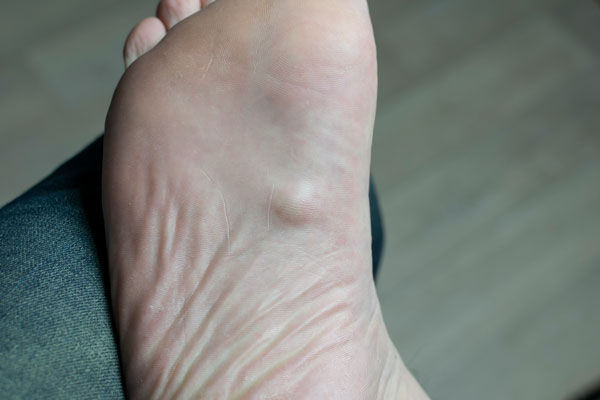What are the symptoms of plantar fibroma?
Plantar fibroma is a benign growth that occurs in the plantar fascia, the thick band of tissue that runs along the bottom of the foot. Common symptoms include:
- Lump or nodule: A firm, round, or oval-shaped lump in the arch of the foot. This is often painless but may vary in size.
- Discomfort or pain: While many people experience little to no pain, some may feel discomfort, especially during activities that put pressure on the affected area, such as walking or standing.
- Tenderness: The area around the fibroma may be tender to the touch, particularly if the growth is larger or pressing against surrounding structures.
- Changes in foot mechanics: As the fibroma grows, it can affect the way a person walks or stands, potentially leading to altered gait or foot fatigue.
- Swelling: In some cases, there may be mild swelling around the fibroma, particularly if there is irritation from footwear.
- Possible hardening of surrounding tissue: Over time, the tissue around the fibroma may become firmer due to the presence of the growth.
Symptoms can vary among individuals, with some experiencing significant discomfort and others only noticing the presence of the lump without pain. If symptoms worsen or interfere with daily activities, it is advisable to seek medical evaluation.
What are the causes of plantar fibroma?
The exact causes of plantar fibroma are not well understood, but several factors are believed to contribute to their development:
- Genetic predisposition: There may be a hereditary component, as plantar fibromas can run in families.
- Trauma or injury: Repeated micro-trauma or injuries to the plantar fascia may trigger the formation of fibromas. This could result from activities that place excessive stress on the feet, such as running or jumping.
- Foot mechanics: Abnormal foot mechanics, such as flat feet or high arches, can lead to uneven distribution of pressure on the plantar fascia, potentially contributing to fibroma development.
- Age: Plantar fibromas are more common in adults, particularly those between the ages of 40 and 60.
- Certain medical conditions: Conditions such as diabetes, liver disease, and Dupuytren’s contracture (a thickening of the tissue in the palm) have been associated with an increased risk of plantar fibromas.
- Environmental factors: Prolonged standing or wearing ill-fitting shoes may also contribute to the development of fibromas.
Understanding these potential causes can help in identifying individuals at higher risk and may aid in prevention strategies.
What is the treatment for plantar fibroma?
Treatment for plantar fibroma often depends on the severity of symptoms and the impact on daily activities. Options include:
- Observation: If the fibroma is not causing pain or discomfort, a “wait-and-see” approach may be sufficient.
- Orthotic devices: Custom or over-the-counter shoe inserts can help redistribute pressure on the foot and alleviate discomfort by providing better arch support.
- Corticosteroid injections: These may be used to reduce inflammation and pain around the fibroma, although they do not eliminate the fibroma itself.
- Physical therapy: Stretching and strengthening exercises for the foot and calf can help improve foot mechanics and reduce discomfort.
- Padding or cushioning: Using padding or cushioning in footwear can help protect the fibroma and reduce pressure on it.
- Surgery: If the fibroma is painful or significantly affects mobility, surgical removal may be considered. This option is typically reserved for cases that do not respond to conservative treatments.
- Lifestyle modifications: Adjusting activity levels and wearing supportive footwear can help manage symptoms and prevent further irritation.
Consulting with a healthcare provider is essential to determine the best treatment approach based on individual symptoms and circumstances.

Leave a Reply
You must be logged in to post a comment.